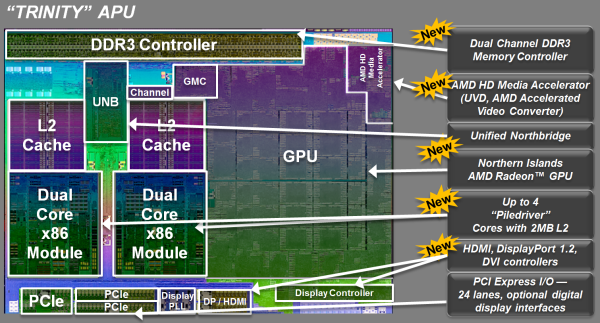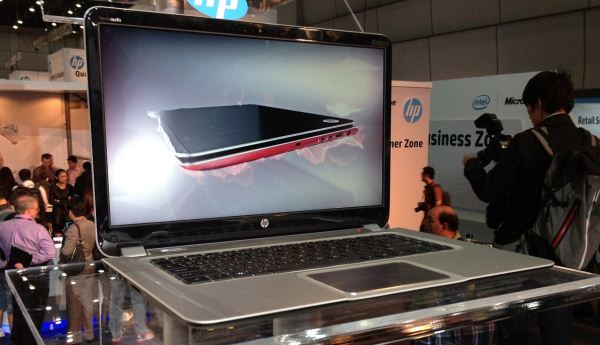The AMD Trinity Review (A10-4600M): A New Hope
by Jarred Walton on May 15, 2012 12:00 AM ESTConclusion: What Makes a Trinity?
I have often wondered about where AMD came up with the codename Trinity (other than the river name, of course). Was it a reference to this being AMD’s third APU? Or maybe AMD was gunning for the Holy Trinity of Performance, Battery Life, and Cost—get wins in all three areas and you’d have a guaranteed best seller! If that’s what AMD was hoping to accomplish, they’ve got a good foundation but we’ll need to see what the laptop OEMs come up with before issuing a final verdict.
To recap, Trinity is AMD’s continued journey down the path they started with Llano. Both CPU and GPU performance have improved over Llano. The general purpose CPU performance gap vs. Intel is somewhere in the 20—25% range, while the GPU advantage continues to be significantly in AMD's favor. It is surprising that Intel's HD 4000 is able to win even in some tests, but overall AMD continues to deliver better GPU performance even compared to Ivy Bridge. It's worth pointing out that the concerns about AMD's battery life from a few years ago are now clearly put to rest. At least at the TDPs we've tested, AMD is easily competitive with Intel on battery life.
AMD's GPU accelerated software lineup this time around is significantly better than it was with Llano, but we're still not quite where we need to be yet. I will hand it to AMD though, progress is clearly being made. Battery life is generally a step forward vs. Llano, which is more than we've been able to say about Ivy Bridge thus far.
The improvements in Piledriver really appear to have saved Trinity. What was a very difficult to recommend architecture in AMD's FX products has really been improved to the point where it's suitable for mobile work. AMD couldn't push performance as aggressively as it would have liked given that it's still on a 32nm process and the APU needs to make money. A move to 2x-nm could help tremendously. Similarly the move to a more efficient VLIW4 GPU architecture and additional tuning helped give AMD a boost in GPU performance without increasing die size. Overall, Trinity is a very well designed part given the process constraints AMD was faced with.
As a notebook platform, Trinity's CPU performance isn’t going to set any new records but it’s certainly fast enough for most users; battery life isn’t at the head of the class, but it’s better than just about anything that doesn’t qualify as an ultrabook; and finally there’s the question of cost. That last item isn’t really in AMD’s control, as the final cost of a laptop is a product of many design decisions, so let’s do some quick investigation into laptop pricing.
If you figure on memory, motherboard, chassis, LCD, and storage as all being the same, a typical laptop will have a starting price point of around $300—for a cheap, injection molded plastic shell, 4GB RAM, a 5400RPM HDD, a 1366x768 TN panel, and a no-frills feature set. Take that same basic platform and you can make an Intel laptop and have a BoM (Bill of Materials) cost of around $450, or you can make an AMD laptop and your BoM might start at $400. Depending on what other upgrades an OEM makes, as well as marketing, R&D, and profit, and we end up at a final price tag that might be $600 for a Trinity laptop compared to $700 for an Ivy Bridge laptop. The problem is that AMD doesn't just compete against vanilla Ivy Bridge; it has to compete against all the existing laptops as well.
Right now, Llano A8 laptops at Newegg have a starting price of $480 for an A8-3500M Acer Aspire, and they range up to $700 for a 17.3” HP dv7. The highest performance laptop of the bunch is probably Samsung’s Series 3, which uses an A8-3510MX APU and goes for $680. I suspect we’ll see similar pricing for Trinity laptops. On the Sandy Bridge Core i3/i5 side of the fence, Newegg has a much larger selection of laptops, starting at $430 for a Lenovo G570, $550 for the cheapest Core i5 model (again from Acer), and going up to $680 or more for laptops with Core i5 and NVIDIA Optimus graphics. Or if you prefer some place other than Newegg, you can find Core i5-2450M with GT 540M in Acer’s AS4830TG for $600.
That pretty much defines the maximum price we should expect people to pay for Trinity, as Core i5 with Optimus will deliver better CPU and GPU performance based on our test results. Obviously there are other factors to consider, like build quality of the laptop(s), display quality, battery life, and features, but most people shopping for an inexpensive laptop are going to be looking at cost first and features second. On the other hand, if you want style as a consideration, HP’s new sleekbooks will have Trinity versions starting at $600 for 15.6” and $700 for 14”—though it’s not clear which APU you’ll get at those prices. As long as last-generation Sandy Bridge laptops are at clearing house prices, though, AMD’s partners are going to need to be under $600 for something like the A10-4600M laptop we’re reviewing today. Assuming they can manage that, Trinity should see plenty of volume with the back to school season coming over the next few months.
For those who are interested in more than just the bottom line, as usual the best laptop for you may not be the best laptop for everyone. Trinity in a 14” form factor like our prototype would make for a great laptop to lug around campus for a few years. It would be fast enough for most tasks, small enough to not break your back, battery life would be long enough to last through a full day of classes, and the price would be low enough to not break your bank. And if mom and dad are footing the bill, you even get to disguise the fact that it’s a gaming capable laptop by not having a discrete GPU specifically called out on the features list. On the other hand, if you’re after a higher performance laptop or you want a “real” gaming system—something that can hand high detail settings at 1600x900 for instance—your best bet continues to be laptops with an Intel CPU and a discrete GPU from NVIDIA, at least of the GT 640M level—I’d say AMD GPUs as well, but I’m still waiting for a better switchable graphics solution.
At this point, AMD has done everything they can to provide a compelling mobile solution. The difficulty is that there's no longer a single laptop configuration that will be "best" for everyone, and Trinity only serves to further muddy the water. Intel continues to offer better CPU performance, and if you need graphics—which mostly means you want to play games—they have a good partner with NVIDIA. AMD on the other hand is delivering better integrated graphics performance with less CPU power, and depending on what you want to do that might be a more well rounded approach to mobile computing. What we need to see now are actual laptops and their prices. To trot out a tired old saying once more, "There are no bad products; only bad prices." Now it's up to AMD's partners to make sure Trinity laptops are priced appropriately.












271 Comments
View All Comments
medi01 - Friday, May 18, 2012 - link
Somehow one doesn't wonder at tomsharware, that comparing chips with vastly different price is a bad idea.TC2 - Sunday, May 20, 2012 - link
amd cpu is far behind intel cpu! about gpu! nvidia is also far better as performance & software support! so for professionals and buyers with budget there isn't point to go with amd! :)))but for amd - as good as is get :))) sorry
kevmanw430 - Tuesday, May 22, 2012 - link
Jarred, what version of Skyrim was tested? Bit of a question in a forum discussion, would like to know.Thanks!
JarredWalton - Wednesday, May 23, 2012 - link
Running the Steam variant, so it's automatically updated. At time of testing, I believe it was version 1.4 (with high res texture pack). The tested sequence is in the area of Whiterun, as I found in initial playing (on a desktop) that it was one of the more demanding areas. I wanted to find the "worst case" situation for playing the game, so that if you get >30 FPS in our benchmark, you'll generally get >30 FPS throughout the game. There's a reasonable chance that other parts of the game are less CPU intensive and thus might show Trinity in a better light, though it's debatable whether that's more or less meaningful than the current results.seapeople - Tuesday, May 22, 2012 - link
Why do you even read computer reviews then? Every single review I've ever read in my life on any site ever created includes a new, top of the line product in the graph REGARDLESS of what's being reviewed. It's not bias, it's not inattentiveness, it's not even remotely absurd as you state, it's quite simply expected for computer reviews.seapeople - Tuesday, May 22, 2012 - link
This is quite silly. We're not comparing a $90,000 Mercedes to a $16,000 Hyundai, we're comparing a processor that might be in an $800 computer to one that might be in a $600 computer based on how sales are at any particular point in time.It's amazing that two or three negative posters account for roughly 50% of the comments on this thread. Somebody is trying too hard.
Stradi - Friday, May 25, 2012 - link
I'm a bit confused about how this review was done. Are they comparing the APU without the extra discrete GPU against intel Ivy Bridge with discrete GPU from nVIDIA and saying the Ivy Bridge is better for gaming? or is this comparing the APU with AMD's discrete GPU that's on crossfire against intel/nVIDIA setup?I assumed the crossfire setup will actually prevail against ivy bridge/nvidia in terms of gaming. I was waiting for Trinity not because it's got a decent GPU in there, but it gives you the option to crossfire with AMD's discrete GPU. And while I like the nVIDIA's discrete GPU option, I didn't think it can havest the intel HD 4000 graphics power and add to it.
I need some clarification on this. I hope they didn't mean to compare an AMD's new APU with Intel's latest+nVIDIA's latest. Why would any reviewer think that'd represent a fair comparison? why would they put an extra discrete GPU in one machine and say that's a better gaming machine?
rarson - Tuesday, May 29, 2012 - link
The AMD APU is not paired with a discrete APU.Obviously the review is confusing and full of incongruous comparisons, but Jarred and Anandtech aren't going to fix it.
rarson - Tuesday, May 29, 2012 - link
Anandtech now responds to criticism by simply deleting it. Or was that Jarred's doing?R3MF - Friday, June 1, 2012 - link
the slides say OpenCL 1.1, will full support in hardware for 1.2 arrive?